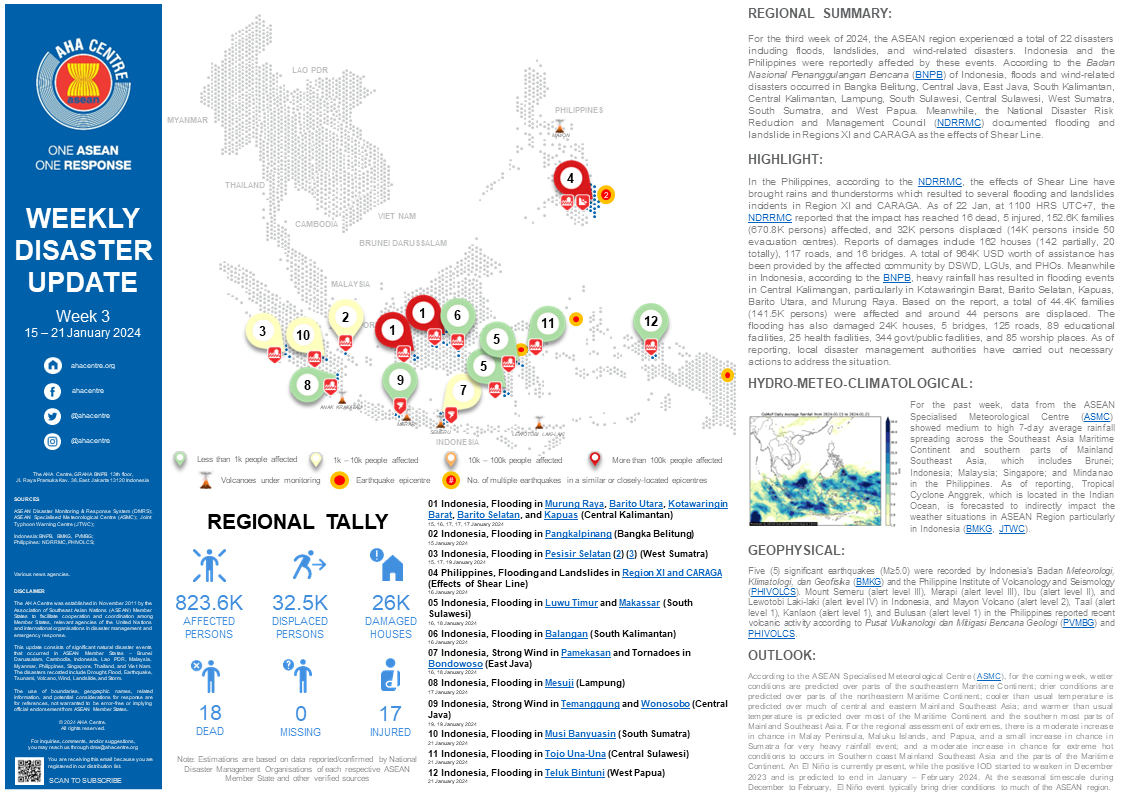
REGIONAL SUMMARY:
For the third week of 2024, the ASEAN region experienced a total of 22 disasters including floods, landslides, and wind-related disasters. Indonesia and the Philippines were reportedly affected by these events. According to the Badan Nasional Penanggulangan Bencana (BNPB) of Indonesia, floods and wind-related disasters occurred in Bangka Belitung, Central Java, East Java, South Kalimantan, Central Kalimantan, Lampung, South Sulawesi, Central Sulawesi, West Sumatra, South Sumatra, and West Papua. Meanwhile, the National Disaster Risk Reduction and Management Council (NDRRMC) documented flooding and landslide in Regions XI and CARAGA as the effects of Shear Line.
HIGHLIGHT:
In the Philippines, according to the NDRRMC, the effects of Shear Line have brought rains and thunderstorms which resulted to several flooding and landslides incidents in Region XI and CARAGA. As of 22 Jan, at 1100 HRS UTC+7, the NDRRMC reported that the impact has reached 16 dead, 5 injured, 152.6K families (670.8K persons) affected, and 32K persons displaced (14K persons inside 50 evacuation centres). Reports of damages include 162 houses (142 partially, 20 totally), 117 roads, and 16 bridges. A total of 964K USD worth of assistance has been provided by the affected community by DSWD, LGUs, and PHOs. Meanwhile in Indonesia, according to the BNPB, heavy rainfall has resulted in flooding events in Central Kalimangan, particularly in Kotawaringin Barat, Barito Selatan, Kapuas, Barito Utara, and Murung Raya. Based on the report, a total of 44.4K families (141.5K persons) were affected and around 44 persons are displaced. The flooding has also damaged 24K houses, 5 bridges, 125 roads, 89 educational facilities, 25 health facilities, 344 govt/public facilities, and 85 worship places. As of reporting, local disaster management authorities have carried out necessary actions to address the situation.
HYDRO-METEO-CLIMATOLOGICAL:
For the past week, data from the ASEAN Specialised Meteorological Centre (ASMC) showed medium to high 7-day average rainfall spreading across the Southeast Asia Maritime Continent and southern parts of Mainland Southeast Asia, which includes Brunei; Indonesia; Malaysia; Singapore; and Mindanao in the Philippines. As of reporting, Tropical Cyclone Anggrek, which is located in the Indian Ocean, is forecasted to indirectly impact the weather situations in ASEAN Region particularly in Indonesia (BMKG, JTWC).
GEOPHYSICAL:
Five (5) significant earthquakes (M>5.0) were recorded by Indonesia’s Badan Meteorologi, Klimatologi, dan Geofisika (BMKG) and the Philippine Institute of Volcanology and Seismology (PHIVOLCS). Mount Semeru (alert level III), Merapi (alert level III), Ibu (alert level II), and Lewotobi Laki-laki (alert level IV) in Indonesia, and Mayon Volcano (alert level 2), Taal (alert level 1), Kanlaon (alert level 1), and Bulusan (alert level 1) in the Philippines reported recent volcanic activity according to Pusat Vulkanologi dan Mitigasi Bencana Geologi (PVMBG) and PHIVOLCS.
OUTLOOK:
According to the ASEAN Specialised Meteorological Centre (ASMC), for the coming week, wetter conditions are predicted over parts of the southeastern Maritime Continent; drier conditions are predicted over parts of the northeastern Maritime Continent; cooler than usual temperature is predicted over much of central and eastern Mainland Southeast Asia; and warmer than usual temperature is predicted over most of the Maritime Continent and the southern most parts of Mainland Southeast Asia. For the regional assessment of extremes, there is a moderate increase in chance in Malay Peninsula, Maluku Islands, and Papua, and a small increase in chance in Sumatra for very heavy rainfall event; and a moderate increase in chance for extreme hot conditions to occurs in Southern coast Mainland Southeast Asia and the parts of the Maritime Continent. An El Niño is currently present, while the positive IOD started to weaken in December 2023 and is predicted to end in January – February 2024. At the seasonal timescale during December to February, El Niño event typically bring drier conditions to much of the ASEAN region.
Sources:
ASEAN Disaster Monitoring & Response System (DMRS); ASEAN Specialised Meteorological Centre (ASMC); Joint Typhoon Warning Centre (JTWC);
Indonesia: BNPB, BMKG, PVMBG;
Philippines: NDRRMC, PHIVOLCS;
Various news agencies.







